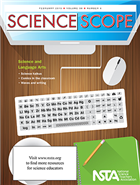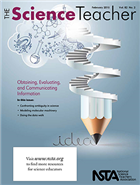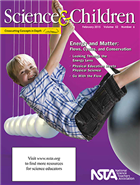Science and literacy
By Mary Bigelow
Posted on 2015-02-24
Every teacher is a literacy teacher. Each discipline, including science, has a language and strategies for communicating both verbal and nonverbal information. As the TST journal editor notes: “…it turns out that reading and writing comprise over half of the work of practicing scientists and engineers.” Reflecting this reality, Obtaining, evaluating, and communicating information is one of the Scientific and Engineering Practices in the NGSS. The two secondary journals this month focus on communication and literacy in science, while the elementary journal has ideas for studying (and communicating about) energy and matter.
 Science Scope: Science and Language Arts
Science Scope: Science and Language Arts
This month’s Guest Editorial Our Science Story: When inquiry meets the Common Core describes how a middle school uses science journaling as a means of integrating science and literacy. Using Disciplinary Literacy Strategies to Enhance Student Learning illustrates strategies such as concept maps and summarization. Science Haiku Art provides examples of a non-traditional way for students to communicate their learning. And if vocabulary is a challenge for students, take a look at Tried and True: The many faces of word walls in middle school science classrooms.
Here are some additional SciLinks that provide content information and suggestions for additional activities and investigations related to this month’s featured articles:
- Reading and Writing Alignment Across Content Areas [SciLinks: Characteristics of Living Things]
- Teaching Graph Literacy Across the Curriculum [SciLinks: Graphing]
- The Who, What, When, Where, and How of Waves [SciLinks: Waves, Wavelength, Reflection and Refraction]
- Comic Relief: Using Comics and Illustrated Trade Books to Support Science Learning in First-Year English Language Learners [SciLinks: Rocks, Earth’s Structure]

The Science Teacher: Obtaining, Evaluating, and Communicating Information
TST’s Career of the Month describes the work of a Science Writer.
Here are some additional SciLinks with weblinks for content information and suggestions for additional activities and investigations related to this month’s featured articles:
- Sinking In and Beyond an Equation [SciLinks: Buoyancy, Density, Density of Water, Graphing Data]
- Confronting Ambiguity in Science [SciLinks: Water Quality, Watersheds]
- Doing the Data Walk [SciLinks: Velocity, Motion]
- Modeling Molecular Machinery [SciLinks: Proteins, DNA Structure and Function, Protein Synthesis]

This month’s Science & Children focuses on Energy and Matter, two concepts that can be challenging for younger students.
The article Science 101: How Should We Label Different Kinds of Energy? has a good refresher on the topic. And here are some additional SciLinks with weblinks for content information and suggestions for additional activities and investigations related to this month’s featured articles:
- Looking Through the Energy Lens [SciLinks: Energy, Energy Transformations]
- Go With the Flow [SciLinks: Ecosystems, Energy Pyramid, Food Chains, Food Webs]
- Physical Education Meets Physical Science [SciLinks: Forces and Motion, Simple Machines]
- How Does My Brain Pay Attention [SciLinks Human Brain]
- Inquiry-Based Science and the Next Generation Science Standards: A Magnetic Attraction [SciLinks: Magnets, Magnetic Materials]
- Teaching Through Trade Books: Understanding Matter and Energy [SciLinks: States of Matter, Describing Matter, Energy Transformations]
- The Early Years: Where does the “warm” go? [SciLinks: Heat and Temperature]
One of the many benefits of being an NSTA member is having access to all of the journals (including past issues) online. Regardless of the grade level you teach, the journals have ideas for authentic activities and investigations that can be used, adapted, or extended for different levels of student interest and experience. Most of the activities are aligned with the NGSS.
Disclaimer: The views expressed in this blog post are those of the author(s) and do not necessarily reflect the official position of the National Science Teaching Association (NSTA).


